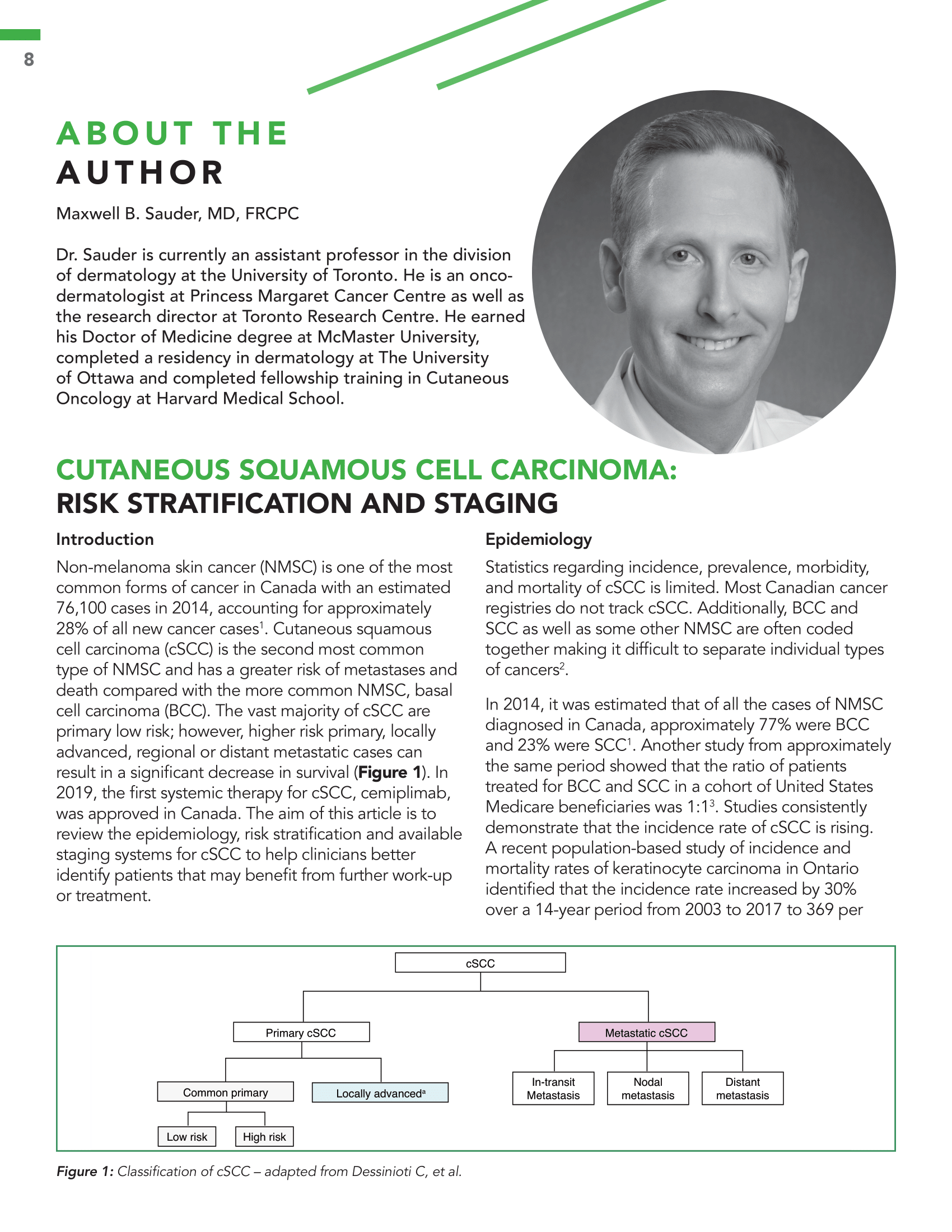Cutaneous Squamous Cell Carcinoma: Risk Stratification and Staging
Abstract
Non-melanoma skin cancer (NMSC) is one of the most common forms of cancer in Canada with an estimated 76,100 cases in 2014, accounting for approximately 28% of all new cancer cases. Cutaneous squamous cell carcinoma (cSCC) is the second most common type of NMSC and has a greater risk of metastases and death compared with the more common NMSC, basal cell carcinoma (BCC). The vast majority of cSCC are primary low risk; however, higher risk primary, locally advanced, regional or distant metastatic cases can result in a significant decrease in survival. In 2019, the first systemic therapy for cSCC, cemiplimab, was approved in Canada. The aim of this article is to review the epidemiology, risk stratification and available staging systems for cSCC to help clinicians better identify patients that may benefit from further work-up or treatment.
References
Public Health Agency of Canada (phac). Non melanoma skin cancer [Web page]. Ottawa, ON: phac; 2014. [Available at https://www.canada.ca/en/public-health/services/chronic-diseases/cancer/non-melanoma-skin-cancer.html; cited 06 Mar 2022]
Dessinioti C, Pitoulias M, Stratigos AJ. Epidemiology of advanced cutaneous squamous cell carcinoma. J Eur Acad Dermatol Venereol. 2022 Jan;36(1):39-50. doi: 10.1111/jdv.17709. Epub 2021 Oct 11. PMID: 34592000.
Rogers HW, Weinstock MA, Feldman SR, Coldiron BM. Incidence Estimate of Nonmelanoma Skin Cancer (Keratinocyte Carcinomas) in the U.S. Population, 2012. JAMA Dermatol. 2015 Oct;151(10):1081-6. doi: 10.1001/jamadermatol.2015.1187. PMID: 25928283.
Tang E, Fung K, Chan AW. Incidence and mortality rates of keratinocyte carcinoma from 1998-2017: a population-based study of sex differences in Ontario, Canada. CMAJ. 2021 Oct 4;193(39):E1516-E1524. doi: 10.1503/cmaj.210595. PMID: 34607845; PMCID: PMC8568084.
Brantsch KD, Meisner C, Schönfisch B, Trilling B, Wehner-Caroli J, Röcken M, Breuninger H. Analysis of risk factors determining prognosis of cutaneous squamous-cell carcinoma: a prospective study. Lancet Oncol. 2008 Aug;9(8):713-20. doi: 10.1016/S1470-2045(08)70178-5. Epub 2008 Jul 9. PMID: 18617440.
Burton KA, Ashack KA, Khachemoune A. Cutaneous Squamous Cell Carcinoma: A Review of High-Risk and Metastatic Disease. Am J Clin Dermatol. 2016 Oct;17(5):491-508. doi: 10.1007/s40257-016-0207-3. PMID: 27358187.
Eisemann N, Jansen L, Castro FA, Chen T, Eberle A, Nennecke A, Zeissig SR, Brenner H, Katalinic A; GEKID Cancer Survival Working Group. Survival with nonmelanoma skin cancer in Germany. Br J Dermatol. 2016 Apr;174(4):778-85. doi: 10.1111/bjd.14352. Epub 2016 Mar 22. PMID: 26676514.
Brunner M, Veness MJ, Ch’ng S, Elliott M, Clark JR. Distant metastases from cutaneous squamous cell carcinoma–analysis of AJCC stage IV. Head Neck. 2013 Jan;35(1):72-5. doi: 10.1002/hed.22913. Epub 2012 Jan 20. PMID: 22266877.
SchmultsCB,R. AasiSZ, AlamM, AndersenJS, BordeauxJ, BowenGM, Carson W, et al. Squamous cell skin cancer. Version 2.2020- July 14, 2020. NCCN Clinical Practice Guidelines in Oncology (NCCN guidelines). Accessed 06 Mar 2022. 2020; https://www.nccn.org/professionals/ physician_gls/pdf/squamous.pdf.
Keohane SG, Botting J, Budny PG, Dolan OM, Fife K, Harwood CA, Mallipeddi R, Marsden JR, Motley RJ, Newlands C, Proby C, Rembielak A, Slater DN, Smithson JA, Buckley P, Fairbrother P, Hashme M, Mohd Mustapa MF, Exton LS; British Association of Dermatologists’ Clinical Standards Unit. British Association of Dermatologists guidelines for the management of people with cutaneous squamous cell carcinoma 2020. Br J Dermatol. 2021 Mar;184(3):401-414. doi: 10.1111/bjd.19621. Epub 2021 Jan 18. Erratum in: Br J Dermatol. 2021 Sep;185(3):686. PMID: 33150585.
Stratigos AJ, Garbe C, Dessinioti C, Lebbe C, Bataille V, Bastholt L, Dreno B, Fargnoli MC, Forsea AM, Frenard C, Harwood CΑ, Hauschild A, Hoeller C, Kandolf-Sekulovic L, Kaufmann R, Kelleners-Smeets NW, Malvehy J, Del Marmol V, Middleton MR, Moreno-Ramirez D, Pellecani G, Peris K, Saiag P, van den Beuken-van Everdingen MHJ, Vieira R, Zalaudek I, Eggermont AMM, Grob JJ; European Dermatology Forum (EDF), the European Association of Dermato-Oncology (EADO) and the European Organization for Research and Treatment of Cancer (EORTC). European interdisciplinary guideline on invasive squamous cell carcinoma of the skin: Part 1. epidemiology, diagnostics and prevention. Eur J Cancer. 2020 Mar;128:60-82. doi: 10.1016/j.ejca.2020.01.007. Epub 2020 Feb 26. PMID: 32113941.
Thompson AK, Kelley BF, Prokop LJ, Murad MH, Baum CL. Risk Factors for Cutaneous Squamous Cell Carcinoma Recurrence, Metastasis, and Disease-Specific Death: A Systematic Review and Meta-analysis. JAMA Dermatol. 2016 Apr;152(4):419-28. doi: 10.1001/jamadermatol.2015.4994. PMID: 26762219; PMCID: PMC4833641.
Zeng S, Fu L, Zhou P, Ling H. Identifying risk factors for the prognosis of head and neck cutaneous squamous cell carcinoma: A systematic review and meta-analysis. PLoS One. 2020 Sep 29;15(9):e0239586. doi: 10.1371/journal.pone.0239586. PMID: 32991600; PMCID: PMC7523977.
Ruiz ES, Karia PS, Besaw R, Schmults CD. Performance of the American Joint Committee on Cancer Staging Manual, 8th Edition vs the Brigham and Women’s Hospital Tumor Classification System for Cutaneous Squamous Cell Carcinoma. JAMA Dermatol. 2019 Jul 1;155(7):819-825. doi: 10.1001/jamadermatol.2019.0032. PMID: 30969315; PMCID: PMC6583833.
Venables ZC, Tokez S, Hollestein LM, Mooyaart AL, van den Bos RR, Rous B, Leigh IM, Nijsten T, Wakkee M. Validation of Four Cutaneous Squamous Cell Carcinoma Staging Systems Using Nationwide Data. Br J Dermatol. 2021 Dec 3. doi: 10.1111/bjd.20909. Epub ahead of print. PMID: 34862598.
Work Group; Invited Reviewers, Kim JYS, Kozlow JH, Mittal B, Moyer J, Olenecki T, Rodgers P. Guidelines of care for the management of cutaneous squamous cell carcinoma. J Am Acad Dermatol. 2018 Mar;78(3):560-578. doi: 10.1016/j.jaad.2017.10.007. Epub 2018 Jan 10. PMID: 29331386; PMCID: PMC6652228.
Karia PS, Han J, Schmults CD. Cutaneous squamous cell carcinoma: estimated incidence of disease, nodal metastasis, and deaths from disease in the United States, 2012. J Am Acad Dermatol. 2013 Jun;68(6):957-66. doi: 10.1016/j.jaad.2012.11.037. Epub 2013 Feb 1. PMID: 23375456


